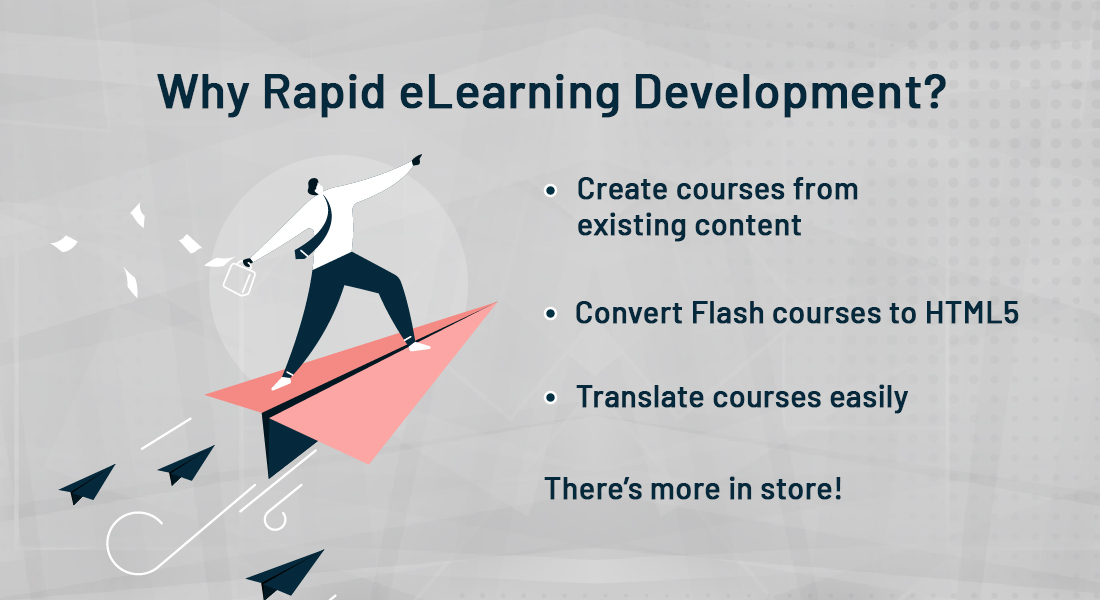3 Common Goals of SMEs and IDs in Rapid eLearning
Both SMEs and IDs have a crucial role to play in rapid eLearning development. Their contribution is valuable and indispensable. Read this blog to know how their involvement make a difference in rapid eLearning development.

As a training manager you must be facing the urgent need of shifting in-person classroom training to virtual training solutions due to the COVID-19 pandemic. With all your employees working from home, Instructor-led Training (ILT) is out of picture for the next several months. Hence, converting your classroom training to eLearning rapidly is the need of the hour! Why? Because rapid eLearning ensures the delivery of unhindered training.
Using existing training content, robust instructional design strategies, agile project management, and rapid authoring tools accelerates the development process, making it possible to rollout eLearning courses quickly. Needless to say, rapid eLearning can be your best solution to revive workplace learning hampered due to COVID-19.
What are the Common Goals of SMEs and IDs in Rapid eLearning?
- Understand requirements
- Utilize interaction time effectively
- Design an engaging rapid eLearning program
However, most of us are still unsure about the roles of SMEs and IDs in rapid eLearning. Do SMES drive the design and development process? Do IDs just play a minor role in rapid eLearning?
Read this blog to discover the role of the SME and the common goals of IDs and SMEs in rapid eLearning design and development.
covid-2:
Role of SMEs in Rapid eLearning Development
SMEs are indispensable in rapid eLearning, especially when you are working on content that’s specific to a certain industry and is highly technical in nature. This is because SMEs:
- Have the domain knowledge and are the right people to address subject-related queries
- Validate the content to be included in the training program
- Play an important role in the review of the rapid eLearning courses to ensure the content has been explained correctly
However, SMEs are usually hard-pressed for time. All said and done, developing eLearning courses is not their primary role. And though SMEs may be excellent at classroom training, they may not be well-versed in instructional design for online training. If you want your rapid eLearning courses to make an impact on your learners, the role of instructional designers cannot be ignored.
Explore popular instructional design strategies for learner-centric eLearning
Role of Instructional Designers in Rapid E-learning Development
Most often, an instructional designer doubles up as an eLearning developer as well. So there’s every chance that the instructional designer is not only involved in designing the course but also develops the course using authoring tools, thus making him a rapid eLearning expert. In some cases, it’s not so depending on the authoring tool expertise of the instructional designer. Here’s what instructional designers bring to the table:
- Thorough analysis and structuring of content in a logical flow
- Knowledge of instructional design principles to ensure the effectiveness of eLearning
- Awareness of eLearning authoring tools and their capabilities (most instructional designers have the skillsets to develop courses using authoring tools)
Common Goals of SMEs and Instructional Designers
Let’s look at some common goals SMEs and instructional designers can follow for the smooth development of rapid eLearning courses.
1. Understand Requirements
It is essential that both the SME and the instructional designer understand the requirements or expectations from the course. The content expert (SME) has the responsibility of ensuring the content is factually correct.
The instructional designer (learning expert) on the other hand needs to ask the SME, the right questions to extract relevant information. The SME is no doubt the content expert, but the learning expert is the one who understands how people learn best and is able to apply the right instructional strategy to deliver an effective eLearning course.
2. Utilize Interaction Time Effectively
Communication between the instructional designer and the SME plays a huge role in the success of any rapid eLearning project. After a project plan is finalized, the onus is on the ID to:
- Involve SMEs right from the beginning of the project
- Get the buy-in from SMEs on their scheduled review timelines
- Interact with SMEs to determine the objectives of the training program
- Get SMEs’ approval on the course outline and subsequently the storyboards
- Get SME approval on the final course
SMEs usually have other responsibilities at work and may not be available to clarify queries anytime. So it is essential that the instructional designer collates queries and gets them clarified by the SME. Plan in advance and schedule meetings/calls with the SME. This can help in the effective utilization of time.
Using knowledge maps (visual representation mapping the course outline to the relevant content) can make it easier for SMEs to understand the relevance of a question the learning expert might have. Completing reviews on time and sharing feedback with the learning experts is a responsibility of the SME and facilitates smooth rapid eLearning development.
3. Design an Engaging Rapid eLearning Program
The responsibility of designing an engaging and interactive eLearning course lies with the instructional designer. But to do that, they will have to pose the right questions to the SME. Consider the example of a rapid eLearning course on process training. Here are a few examples of questions that instructional designers can ask SMEs:
- What can go wrong if employees do not follow the process?
- What are the common mistakes made by newcomers while following this process?
- Can you share real-world scenarios or examples from the workplace?
If an SME needs additional information added, then again it is for the instructional designer to check if it’s need-to-know or nice-to-know information. SMEs cherish the content they provide and most of them may not like the idea of chopping that information. In such cases, suggest alternatives such as adding additional information in the Resources section.
Endnote
When instructional designers and SMEs work together collaboratively and keep the course focused on learners’ needs, it results in a smooth rapid eLearning design and development process. Right from the initial storyboards to the prototype to the final deliverable, the SME has an important role to play in disseminating correct information that forms the basis for effective instructional design.
On a different note, saving your SME’s time is also a challenge amidst training disruptions due to COVID-19. They must be even more hard-pressed for time right now, considering their major role in strategizing critical solutions, resolving customer issues and framing revised action plan for their domains.
Download this eBook to find out 10 tips to save your SME’s time.






